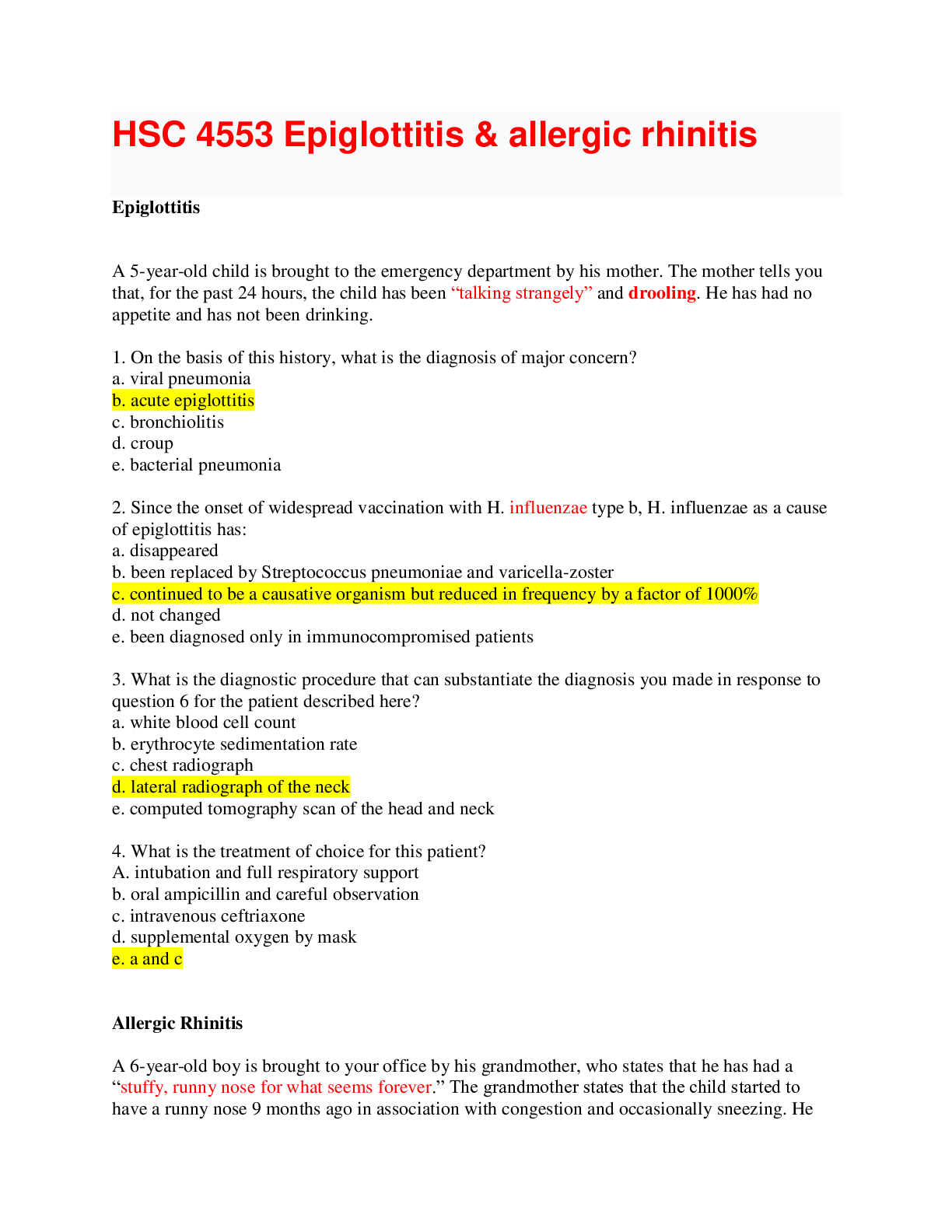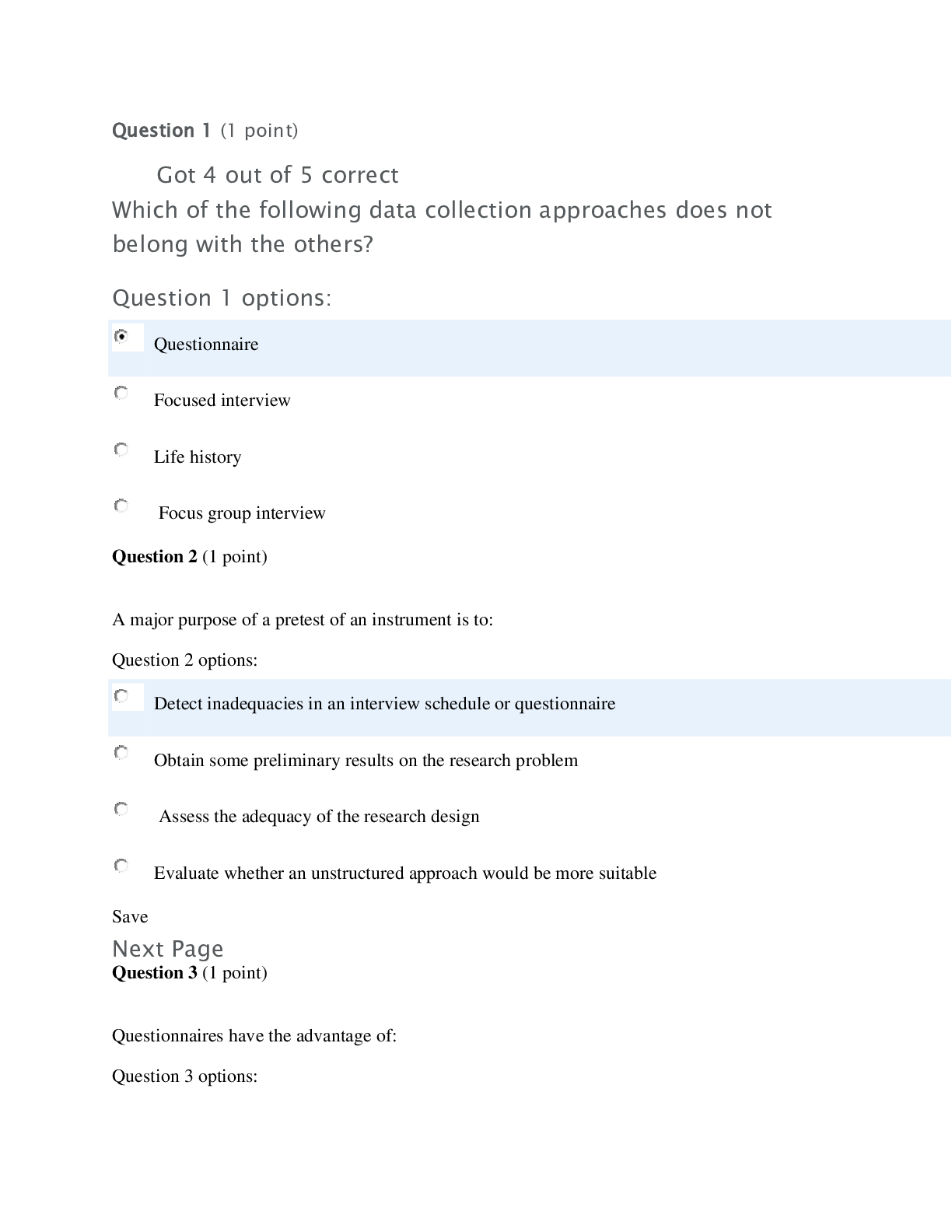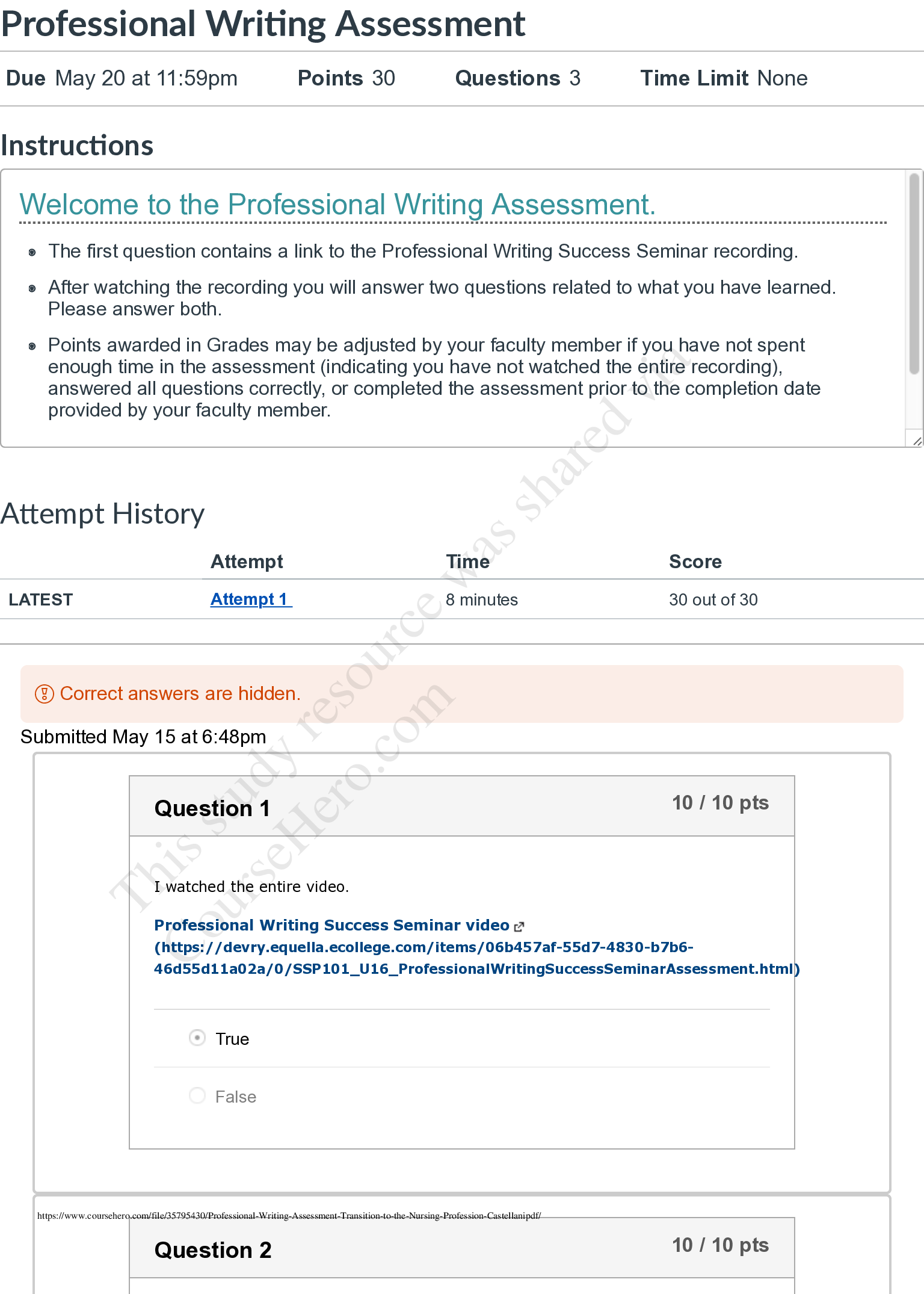HSC 4553 Epiglottitis & allergic rhinitis Questions And Answers 2020
Document Content and Description Below
HSC 4553 Epiglottitis & allergic rhinitis Epiglottitis A 5-year-old child is brought to the emergency department by his mother. The mother tells you that, for the past 24 hours, the child has ... been “talking strangely” and drooling. He has had no appetite and has not been drinking. 1. On the basis of this history, what is the diagnosis of major concern? a. viral pneumonia b. acute epiglottitis c. bronchiolitis d. croup e. bacterial pneumonia 2. Since the onset of widespread vaccination with H. influenzae type b, H. influenzae as a cause of epiglottitis has: a. disappeared b. been replaced by Streptococcus pneumoniae and varicella-zoster c. continued to be a causative organism but reduced in frequency by a factor of 1000% d. not changed e. been diagnosed only in immunocompromised patients 3. What is the diagnostic procedure that can substantiate the diagnosis you made in response to question 6 for the patient described here? a. white blood cell count b. erythrocyte sedimentation rate c. chest radiograph d. lateral radiograph of the neck e. computed tomography scan of the head and neck 4. What is the treatment of choice for this patient? A. intubation and full respiratory support b. oral ampicillin and careful observation c. intravenous ceftriaxone d. supplemental oxygen by mask e. a and c Allergic Rhinitis A 6-year-old boy is brought to your office by his grandmother, who states that he has had a “stuffy, runny nose for what seems forever.” The grandmother states that the child started to have a runny nose 9 months ago in association with congestion and occasionally sneezing. He has not had any fever, cough, wheezing, headaches, or ear pain. Over-the-counter “cold medicines” have helped somewhat. On further questioning, you find out that the child lives with his parents in a fully carpeted home. He also received a puppy for his birthday a few months ago. The only significant past medical history is that of some mild eczema. The mother has a history of asthma as a child. On examination, there is bilateral clear rhinorrhea and turbinate swelling with pale blue mucosa. The child is mouth breathing and several times during the examination is noted to rub his nose upward with the palm of his hand. Some cobblestoning is noted on the posterior pharynx. The chest examination is negative. 1. What is the most likely diagnosis in this child? a. infectious rhinitis b. nasal foreign body c. seasonal allergic rhinitis d. perennial allergic rhinitis e. rhinitis medicamentosa 3. Elevation of which of the following immunoglobulin (Ig) classes is associated with this condition? a. IgA b. IgE c. IgG d. IgM e. IgD 4. This condition is most often associated with what type(s) of allergen(s)? a. house dust mites, animal dander, and molds b. pollen, especially from grasses, trees, and weeds c. cigarette smoke d. nonspecific environmental pollutants e. all of the above 5. Which of the following physical signs associated with the condition described here is found commonly in children but not in adults? a. “shiners” b. nasal crease c. mouth breathing d. the “salute sign” e. posterior pharyngeal wall lymphoid hyperplasia 6. Which of the following is the most common predisposing factor to this child’s condition? a. family history b. smoke exposure c. chronic cold medication use d. asthma e. eczema A father who owns a landscaping business brings his 3-year-old daughter to your office with a complaint of 6 weeks of runny nose, congestion, sneezing, and cough. He further notes that the child seems to have long “colds,” especially during spring and early summer. The child experienced a period of difficulty breathing a few days ago and, on account of this, they visited a local emergency department and were given an inhaler. 7. Which of the following is most likely? a. pertussis b. seasonal allergic rhinitis c. gastroesophageal reflux d. common cold e. rhinitis medicamentosa 8. Which of the following would you recommend as part of initial treatment for this patient? a. immunotherapy b. antacids c. refer to an ear, nose, and throat (ENT) specialist d. dietary restrictions e. environmental control measures and allergen avoidance 9. What is the most effective pharmacologic treatment for the condition described here? a. intranasal cromolyn sodium b. intranasal corticosteroids c. antihistamines d. oral or topical decongestants e. leukotriene receptor antagonists 10. The mother of the child calls your office and asks if “blood work” is necessary to confirm the diagnosis before she starts the child on the medications you recommended. You call back and tell her which of the following? a. laboratory testing is not essential for diagnosis or initiation of treatment b. radioallergosorbent testing (RAST) will be ordered c. you will order a rapid strep and monospot d. the child should be tested for food allergies e. you will order nasal smear, complete blood count (CBC), and serum IgE levels 11. Which of the following is not a physiologically based treatment of allergic rhinitis? a. leukotriene receptor antagonist b. oral corticosteroids c. guaifenesin d. antihistamines e. nasal corticosteroids 12. Which of the following systemic diseases can be associated with rhinitis? a. amyloidosis b. sarcoidosis c. Wegener granulomatosis d. hypothyroidism e. all of the above 13. All except which of the following statements about immunotherapy are true? a. around 85% of patients will have significant long-lasting relief with therapy b. it should not be initiated during pregnancy c. anaphylaxis is rare d. skin testing must be done before initiation e. it is more effective for perennial rhinitis than for seasonal rhinitis 14. In patients with significant allergic rhinitis, quality of life is: a. as debilitating as that of patients with moderate to severe reactive airway disease b. compromised as a result of decreased restful sleep c. not impaired in any significant way d. normal unless there are other comorbid conditions e. a and b 16. Which of the following is (are) true regarding rhinitis medicamentosa? a. it is chronic nasal congestion that results from prolonged use of topical nasal decongestants b. the rebound swelling is caused by interstitial edema c. topical decongestants should not be used for more than 5 days to avoid this condition d. similar consequences can result from cocaine use e. all of the above [Show More]
Last updated: 1 year ago
Preview 1 out of 4 pages

Buy this document to get the full access instantly
Instant Download Access after purchase
Add to cartInstant download
We Accept:

Reviews( 0 )
$10.00
Document information
Connected school, study & course
About the document
Uploaded On
Aug 21, 2020
Number of pages
4
Written in
Additional information
This document has been written for:
Uploaded
Aug 21, 2020
Downloads
0
Views
26





.png)







